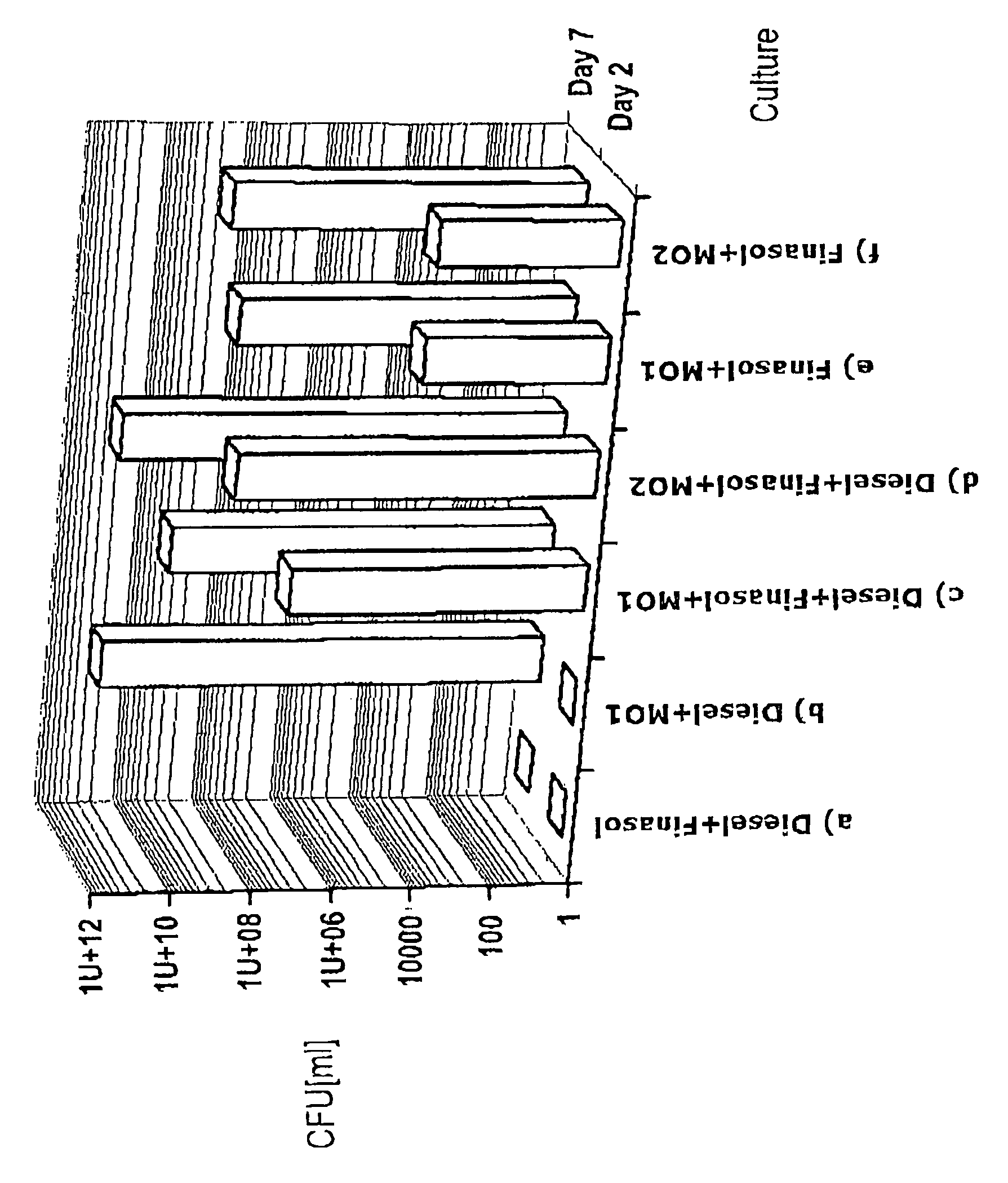Method and product for decomposing organic compounds
a technology of organic compounds and decomposition methods, applied in biological water/sewage treatment, transportation and packaging, treatment water, etc., can solve the problems of contaminating the surrounding soil, chemical and photochemical decomposition of oil components floating on the water surface, accidents, etc., to accelerate the decomposition, increase the microbial progeny rate, and influence quickly
- Summary
- Abstract
- Description
- Claims
- Application Information
AI Technical Summary
Benefits of technology
Problems solved by technology
Method used
Image
Examples
example 1
[0052]For the illustration of the microbial growth on a defined carbon source, a minimal medium without carbon source was generated:
[0053]
Na2HPO47.2gKH2PO43.0gNaCl0.5gNH4Cl1.0gDist. water1000ml
[0054]The solution was set to a value of pH 7.4 with NaOH or HCl, respectively. After the autoclaving,
[0055]
1M MgSO42.0 ml2M CaCl20.1 ml
were added.
[0056]The medium was distributed to six cultures with 200 ml in suitable containers.
[0057]As microorganisms, two different microorganism mixtures MO1 (aqueous solution containing Pseudomonas azotoformans, P. grimontii and P. marginalis) and MO2 (aqueous solution containing Penicillium sp. and Pseudomonas azotoformans, P. grimontii and P. marginalis) by the company Inocre® were used. The consortia (Mo1 and MO2) of the microorganisms were produced as follows: The stems described above were grown in mineral medium (minimal medium see above with 1% (wt) fructose as carbon source) as pure cultures up to cell numbers of more than 108 CFU / ml The pure cultu...
example 2
[0061]Cultures with 200 ml minimal medium each were produced. Depending on the problem, the following components were added:[0062]a) To determine the effect of Finasol only on a diesel oil layer, a culture was polluted with 2 ml diesel oil and subsequently sprayed with 0.1 g (5% (w / v)) Finasol.[0063]b) To test the effect of the microorganism mixture 1 (MO1) only on diesel oil, a culture was polluted with 2 ml diesel oil and subsequently sprayed with 0.1 ml of MO1 with 108 CFU / ml in aqueous solution.[0064]c) To test the joint effect of Finasol and MO1 on diesel oil, a culture was polluted with 2 ml diesel oil, sprayed with 0.1 ml MO1 (108 CFU / ml in aqueous solution), and subsequently superimposed with 0.1 g Finasol.[0065]d) To test the joint effect of Finasol and a second microorganism mixture (MO2) on diesel oil, a culture was polluted with 2 ml diesel oil, sprayed with 0.1 ml MO2 (109 CFU / ml), and subsequently superimposed with 0.1 g Finasol.[0066]e) To determine whether Finasol is...
example 3
[0069]The interpretation of the experiments took place pursuant to visual parameters and by the determination of the microbiological growth. Microbial growth is quantified as colony forming units (CFU / ml), see FIG. 1
1. Visual Evaluation
[0070]The visible effects of the experiments were documented on day 2 and day 7. The following resulted for the various cultures:[0071]a) Day 2: distinct clouding, corresponding to fine diesel oil droplets distribution obtained by Diesel dispersion in presence of Finasol.[0072]Day 7 like day 2[0073]b) Day 2: culture clear[0074]Day 7: distinct clouding, caused by the growth of MO1, sedimented biomass can be recognized.[0075]c) Day 2: distinct clouding, corresponding to fine diesel oil droplets distribution obtained by Diesel dispersion in presence of Finasol.[0076]Day 7 like day 2[0077]d) Day 2: distinct clouding, corresponding to fine diesel oil droplets distribution obtained by Diesel dispersion in presence of Finasol.[0078]Day 7 like day 2, but slig...
PUM
| Property | Measurement | Unit |
|---|---|---|
| weight ratio | aaaaa | aaaaa |
| amphoteric | aaaaa | aaaaa |
| concentration | aaaaa | aaaaa |
Abstract
Description
Claims
Application Information
 Login to View More
Login to View More - R&D
- Intellectual Property
- Life Sciences
- Materials
- Tech Scout
- Unparalleled Data Quality
- Higher Quality Content
- 60% Fewer Hallucinations
Browse by: Latest US Patents, China's latest patents, Technical Efficacy Thesaurus, Application Domain, Technology Topic, Popular Technical Reports.
© 2025 PatSnap. All rights reserved.Legal|Privacy policy|Modern Slavery Act Transparency Statement|Sitemap|About US| Contact US: help@patsnap.com

